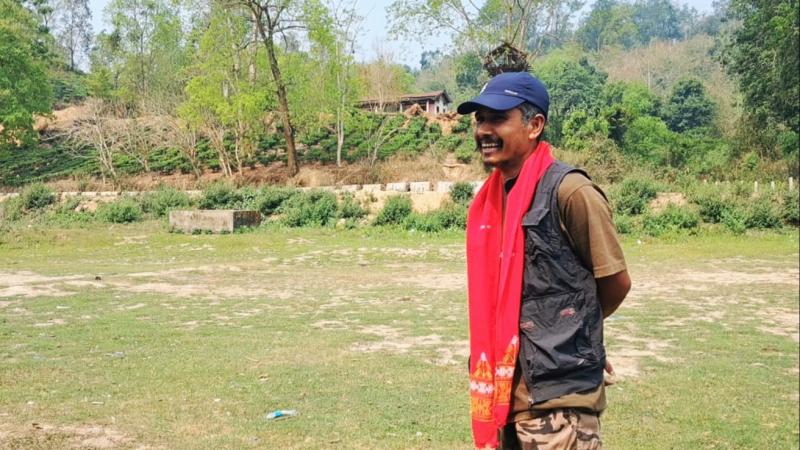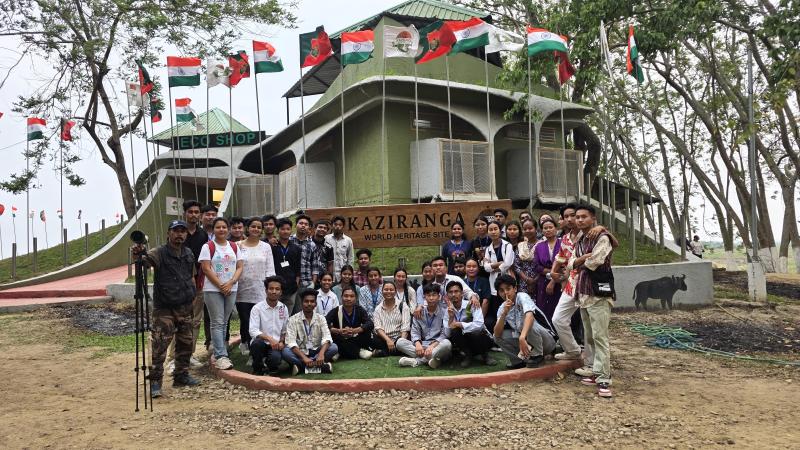Apart from the traditional classroom learning what excite the learning journey for teachers and students are the lessons from the field. Alternative learning environments extend beyond the walls of the classroom and provides a real-life experience and stimulate them to connect theoretical knowledge with practical applicability.
With this objective in mind, the Department of Political Science of Government Model College, Deithor, Karbi Anglong took the initiative to explore the relationship between humans and nature to learn, unlearn, and relearn the meaning of co-existence. As part of this journey, we focused on the inspiring story of Mr. Manoj Gogoi, popularly known as the ‘Wildlife Warrior of Kaziranga’. Loved by the local community and affectionately called Manoj da, he is a renowned wildlife conservationist and recipient of several prestigious awards.
Hailing from Kaziranga, Manoj Gogoi has dedicated his life to protecting wildlife animals and rescuing and rehabilitating snakes and birds. Though he is neither a trained veterinarian nor a biologist, his deep love, long experiences with nature, and selfless service to wildlife make him truly special. So far, he has rescued over 6,000 animals including birds, venomous snakes, pythons, and many others. His work is a powerful reminder that compassion and commitment can make a real difference, even without formal qualifications.
 Photo: Dhunu Nayak
Photo: Dhunu Nayak
Becoming a wildlife rescuer was not something that happened by chance for Manoj Gogoi. He used to work as a tourist guide in Kaziranga, where he saw many animals, birds, rhinos, leopards, snakes, and more. These daily encounters made him think about their safety and inspired him to help them. During floods, he often saw animals struggling to survive. These experiences pushed him to act and become a rescuer. His work is not limited to Kaziranga, Manoj Gogoi has also carried out rescue missions from Karbi Anglong to Goalpara, helping animals in even the most remote areas.
Gogoi shared with students that Ashok Verma, a researcher from Bombay Natural History Society (BNHS) inspired him to join a one-month course at the BNHS in 2006. The experience of rescuing a python in 2007 gave him a new vision of his life. Now, he needs to know how to care for rescued animals and birds- their food, shelter, and behaviour. By observing injured and orphaned animals, he has learned a lot and developed the skills needed to help them return to the wild.
Along with gaining this knowledge, Manoj also started creating a safe place for the animals he rescued. On a barren piece of land owned by his friend Sunil Kumar Sen in Dumjaan village near Kaziranga, he began planting fruit trees, digging small water bodies, and building shelters. Slowly, he turned it into a peaceful home for his rescued animals, whom he treats like his own children. For, Manoj Gogoi, rescuing animals is just the beginning because the real challenge is keeping them alive and safe. Many times, he has stayed up all night, giving warmth to rescued birds and animals, just like a mother cares for her child.
Manoj realised that his mission would only succeed if the local youth and community were involved. As the saying goes, ‘If you want to go far, go together’. So, he began spreading awareness, teaching people, especially the youth about the importance of rescuing and protecting wildlife. He believes that rescue and awareness must go hand in hand.
Manoj Gogoi’s work to protect wild animals grew stronger with support from the Corbett Foundation, which honoured him by conferring the title of ‘Wildlife Warrior’ in 2014. His dedicated efforts gained attention from both local and national media. In 2018, two young filmmakers Dhritiman Kakati and Raktim Hazarika made a documentary about his life and work titled The Man Who ‘Speaks’ Nature. This documentary won the 5th International Nature Film Festival Godollo, Hungary, and Festival International Nature Namur, Belgium. In 2019, Gogoi received the ‘India Star Passion Award’ for his commitment to the environment.

Photo - Losan Prakash Gogoi
During interaction with the students of the department, Manoj highlighted the role of youth in protecting wildlife, especially in the Kaziranga area. Even without any financial help from the government, Manoj stays determined to continue his work with the limited resources he has. Manoj Gogoi may be praised as a hero for wildlife and nature conservation, but for him, the real hero is the Karbi Hills, which are part of the Kaziranga landscape. These hills act as a safe shelter for animals during floods, and he calls them the true protectors of Kaziranga.
However, the forests in the Karbi Hills are slowly disappearing, and this worries Manoj. When asked about the loss of forests, he said it could be due to natural causes or human actions. But once people destroy nature, they must be ready to face the consequences. The rise of hotels, resorts, and other commercial developments is harming the environment and wildlife. Encroaching into animal habitats is the main reason for growing human-animal conflicts. Cutting down of forests, setting up of commercial plantations, and building in the name of development are causing more clashes between humans and animals, especially elephants.
Manoj is also concerned about the rising number of tourists visiting Kaziranga every year. While tourism brings jobs and money, unregulated tourism is turning Kaziranga into a commercial place. He believes everyone must act now to protect Kaziranga and its surroundings before it is too late.
Manoj Gogoi’s hard work is a strong example of how determination and love for nature can inspire anyone to become a protector of the environment. The students went back home with smiles and a new understanding that learning doesn’t only happen in classrooms or books. It also comes from alternate sources and real-life experiences and from people like Manoj Gogoi. This journey has become a memorable one, helping them reconnect with their roots.